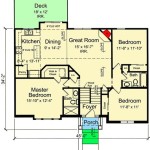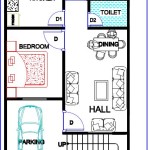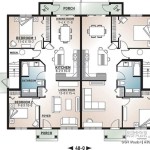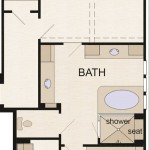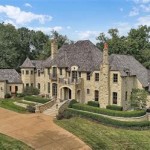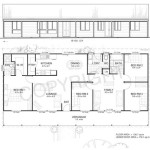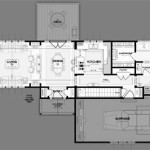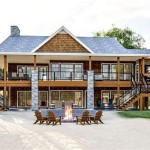House Plan Of 4 Bedrooms: Design Considerations and Functionality
The design and execution of a four-bedroom house plan necessitates careful consideration of various elements, ranging from spatial allocation and functionality to lifestyle compatibility and budget adherence. This article delves into the critical aspects of a four-bedroom house plan, providing a comprehensive overview of design principles, layout options, and essential features to promote both comfort and practicality.
A four-bedroom house plan is typically designed to accommodate a growing family, provide space for guests, or allow for a home office or hobby room. The flexibility offered by this type of plan makes it a popular choice for homeowners seeking both present-day usability and future adaptability. However, successful implementation requires more than simply adding bedrooms; it demands a holistic approach that integrates all aspects of living into a cohesive and functional design.
Understanding Space and Layout Options
The foundation of any successful house plan lies in optimizing the available space and crafting a layout that meets the occupants' specific needs. For a four-bedroom house, several layout options can be considered, each with its own advantages and disadvantages.
One common approach is to group the bedrooms together, typically on the upper floor of a two-story house or along one wing of a single-story dwelling. This arrangement creates a dedicated sleeping area, separating it from the more active living spaces. It often includes a master suite with a private bathroom and walk-in closet, along with shared bathrooms for the other bedrooms. This design promotes privacy and quiet, particularly beneficial for families with children.
Alternatively, a split-bedroom layout can be employed. In this configuration, the master suite is located on one side of the house, while the remaining bedrooms are situated on the opposite side. The living areas, such as the kitchen, dining room, and living room, act as a buffer zone. This design offers enhanced privacy for the master bedroom and can be particularly appealing to families with older children or those who frequently host guests.
Another consideration is the placement of bedrooms relative to natural light and views. Optimizing bedroom orientation to capture morning sunlight or provide pleasant views can significantly enhance the occupants' well-being. Furthermore, careful consideration must be given to noise levels, ensuring that bedrooms are not located near noisy areas such as the garage or street.
The layout should also address the flow between different areas of the house. Seamless transitions between the bedrooms, bathrooms, and living areas are crucial for creating a comfortable and functional living environment. Adequate hallway space is essential to prevent congestion and allow for easy movement throughout the house.
Beyond the bedroom arrangement, the placement of other rooms, such as the kitchen, living room, and dining room, is equally important. An open-concept design, where these spaces are combined into a single, larger area, can create a sense of spaciousness and promote social interaction. However, a more traditional layout, with separate rooms, can offer greater privacy and noise control. The choice depends on the lifestyle and preferences of the occupants.
Essential Features and Functionality
Beyond the basic layout, a well-designed four-bedroom house plan must incorporate essential features that enhance functionality and cater to the needs of its occupants. These features contribute to the overall comfort and usability of the home.
Adequate storage space is paramount. Each bedroom should have a well-organized closet, and additional storage space should be strategically located throughout the house for linens, seasonal items, and other belongings. Walk-in closets in the master suite are a desirable feature, providing ample space for clothing and accessories. Linen closets near the bathrooms and a coat closet near the entrance are also essential.
Bathroom design is another critical aspect. A four-bedroom house typically requires at least two full bathrooms, and potentially a half-bath near the living areas for guests. The master bathroom should be designed as a private retreat, with features such as a soaking tub, separate shower, and double vanity. Shared bathrooms should be designed for efficiency and ease of use, with durable materials and ample counter space.
The kitchen is the heart of the home, and its design should be both functional and aesthetically pleasing. Ample counter space, storage cabinets, and a well-organized layout are essential for food preparation and cooking. A kitchen island can provide additional workspace and seating, while a pantry offers convenient storage for food items. The placement of appliances, such as the refrigerator, oven, and dishwasher, should be carefully considered to optimize workflow.
Laundry rooms are often overlooked but are an important part of a functional house plan. A dedicated laundry room, equipped with a washer, dryer, and folding area, can make laundry chores more efficient. The laundry room should be located in a convenient location, such as near the bedrooms or kitchen, and should have adequate ventilation to prevent moisture buildup.
Outdoor living spaces, such as patios, decks, and porches, extend the living area and provide opportunities for relaxation and entertainment. A well-designed outdoor space should be accessible from the living room or kitchen and should be integrated seamlessly with the surrounding landscape. Features such as outdoor fireplaces, seating areas, and dining tables can enhance the usability of the outdoor space.
Energy efficiency is an increasingly important consideration. Incorporating energy-efficient features, such as proper insulation, energy-efficient windows and doors, and energy-efficient appliances, can significantly reduce energy consumption and lower utility bills. Solar panels can also be considered as a renewable energy source.
Lifestyle Compatibility and Future Adaptability
A successful four-bedroom house plan must be compatible with the lifestyle of its occupants and designed to adapt to their changing needs over time. This requires a thorough understanding of their current and future requirements.
Consider the family's hobbies and interests. If the family enjoys cooking, a large and well-equipped kitchen is essential. If they enjoy gardening, a spacious backyard with plenty of sunlight is desirable. If they enjoy entertaining, a large living room and outdoor space are necessary. The house plan should accommodate these activities and provide dedicated spaces for them.
Think about the family's long-term needs. As the family grows, the house should be able to accommodate their changing needs. For example, a spare bedroom could be used as a home office until it is needed for a child or guest. The house should also be designed to be accessible for people of all ages and abilities. This could include features such as wider doorways, grab bars in the bathrooms, and a ramp or elevator.
The potential for future renovations and additions should also be considered. The house plan should be designed in a way that allows for future expansion, such as adding a second story or extending the living room. This can increase the value of the home and provide greater flexibility for future needs.
The surrounding neighborhood and community should also be taken into account. The house plan should be compatible with the architectural style of the neighborhood and should comply with local building codes and regulations. The proximity to schools, parks, and other amenities should also be considered.
Ultimately, the key to a successful four-bedroom house plan is to create a space that is both functional and comfortable, and that meets the unique needs and preferences of its occupants. Careful planning and attention to detail are essential for achieving this goal.

Beautiful Affordable 4 Bedroom House Plans New Home Design

4 Bedroom House Plan Examples

4 Bedroom House Plans Infinity Homes Custom Built In Mobile Alabama

House Plans 12x12 Meter 4 Bedrooms Hip Roof 40x40 Feet Samhouseplans

Modern 4 Bedroom House Plan Plans Floor

4 Bedroom House Plans Truoba Architect

Contemporary Plan 4 211 Square Feet Bedrooms 5 Bathrooms 5565 00151

40 X 60 Modern House Architectural Plans 4 Bedroom

Plan 45467 4 Bedroom Classic Ranch House With Covered Porc

Minimalist Single Story House Plan With Four Bedrooms And Two Bathrooms Cool Concepts

